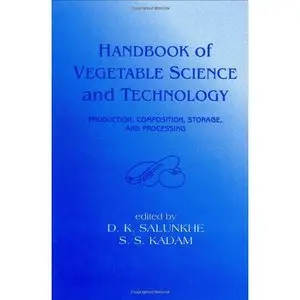S.S. Kadam, D.K. Salunkhe, "Handbook of Vegetable Science and Technology"
1998 | pages: 742 | ISBN: 0824701054 | CHM | 5,7 mb
1998 | pages: 742 | ISBN: 0824701054 | CHM | 5,7 mb
The world's most urgent need is to increase the production of nutritious food so that we may adequately feed the hungry people of the planet. A major and often neglected step toward offering a greater volume of nutritious foods is to prevent loss of food between the time of harvesting and consumption. According to a report published by the National Research Council of the National Academy of Sciences (Washington, D.C., 1978), postharvest losses may be as high as 3040% in both developed and developing nations. With application of adequate technology to prevent their deterioration after harvest, supplies of fresh fruits and vegetables can be increased to the extent of their existing postharvest losses.
Fresh vegetables and fruits are vital sources of minerals, vitamins, and dietary fibers. Both contain nutritionally important compounds, such as vitamins, that cannot be synthesized. They supply certain constituents that other foods do not. Vegetables and fruits contribute over 90% of dietary vitamin C. Green vegetables are a rich source of vitamin A. Similarly, niacin and folic acid (which are required for normal body functions) are present in significant quantity. Because vegetables and fruits are perishable products with high metabolic activity during the postharvest period, proper postharvest handling plays an important role in increasing their availability.
Recent developments in agriculture have contributed significantly to the improvement of vegetable production throughout the world. Similarly, remarkable improvements have been made in the postharvest handling of various vegetables and control of their market diseases. Storage practices have been developed to protect the vegetables and add to consumer appeal. The development of sizing equipment, conveyors, and package fillers all contribute to the success of vegetable handling. New chemicals more effective in decay control have been developed by the chemical industry to serve the fruit and vegetable industry. Improvements in refrigerated rail wagons, trucks, and trailers have helped to reduce losses during transport. All of the information above is scattered in many recent research papers, reviews, bulletins, and books. There was a need to have information on production and postharvest technology of vegetable crops compiled in one volume. This book will be useful to students of horticulture, marketing, food processing and engineering, food science, and nutrition as well as growers, processors, and shippers of vegetables in both developed and developing countries.
My Links



